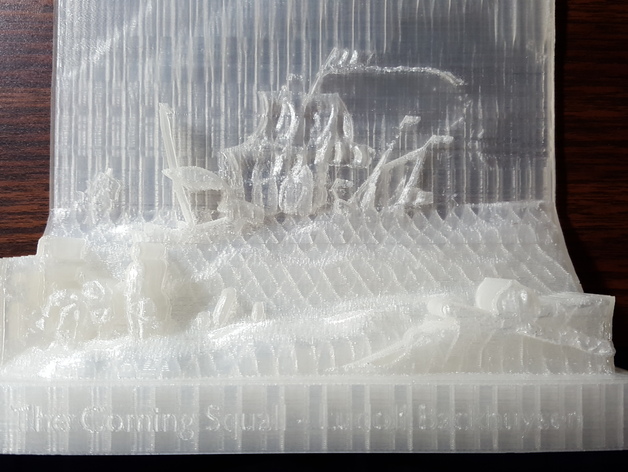
Alberta High School Fine Arts - Printing Classic Paintings
thingiverse
This is a project designed for high school level art courses in the province of Alberta. The curriculum calls for students to experiment with a variety of media creating art, so by having them use digital design programs such as Blender and ZBrush, students can create digital and 3-dimensional versions of classic (or any) paintings. The example that I made is a representation of Ludolf Backhuysen's "The Coming Squall." This has the added benefit of creating 3D representations of classic art that can be experienced by the blind and otherwise visually-impaired.https://www.youtube.com/watch?v=q_KM95Uqqrw Here's the link to my website where you can find progress pictures, connections to the curricula, and the project design: https://2teacher4u.wordpress.com/high-school-fa-3d-classic-paintings/ How I Designed This I used Blender 2.74 to create different objects within the scene, and then used the sculpt mode to texture the objects. Project: 3D Classic Paintings Objectives: This project has outcomes that connect directly to the Alberta High School Fine Art curriculum at all three grade levels. There are also many connections to the Design studies CTS courses. Compositions: Art 10: Students will Extend their knowledge of and familiarity with the elements and principles of design through practise in composing two- and three-dimensional images Use the vocabulary of art criticism to develop and accept analyses of their own works experiment with various representational formats Art 20: Students will Use non-traditional approaches to create compositions in both two and three dimensions solve teacher- and student-developed problems by varying the dominance of design elements for specific visual effects use the vocabulary and techniques of art criticism to interpret and evaluate both their own works and the works of others demonstrate control over various components of compositions Art 30: Students will Use personal experiences as sources for image making develop and solve design problems use the vocabulary and techniques of art criticism to analyze and evaluate their own works in relation to the works of professional artists develop a portfolio of works that will represent their personal style Encounters: Art 10: Students will become aware of the relationship between function and form in artistic productions Art 20: Students will investigate the impact of technology on the intentions and productions of the artist acquire a repertoire of visual skills useful for the comprehension of different art forms Art 30: Students will analyze the factors that generate a work of art, or an artistic movement: the experiences of the artists and the impact of the culture Audiences: The main audience for this project is high school Fine Arts students who have some prior experience with digital design software. This project can easily be fit to post-secondary or junior high school level learning outcomes. Preparation: Students must have access to and experience with digital design software. My recommendation is to use either ZBrush or Blender. Low-powered software like 123D Design won't be helpful for this project as they lack the power and sculpting processes needed to complete it. Students also require access to a 3D printer. Other sculpting and modeling software will do in place of the ones listed above. Steps: Students will: 1) Find a classic painting (portrait or scene) which they enjoy and get the teacher's permission to use it for the assignment 2) Plan and design a digital setup for the 3D representation of the painting. 3) Print their finished model. Results: The model that I provided here is my exemplar to my students. I chose Ludolf Backhuysen's "The Coming Squall" as the painting of my choice and used Blender to create objects for the major things in the scene. I then ordered them by layer height to give a sense of depth to the scene. After that, I textured the faces as best as I could before designing a base for the painting with the title (I'll use Braille next time), and printing it. In the document that I provided on this Thing, you'll find a grading rubric that you're free to use if you wish. If not, I would recommend grading students not off the appearance of the final print, but by the feel. Since the point of the assignment was to create something that a blind person can "see" by feeling, then students should be marked on how well you can determine the scene by using your fingertips, as well as the likeness to the original (in terms of details in the scene or texture), and progress screenshots of their work to cut down the likelihood of plagiarism. Differentiation: Some students may wish to do famous sculptures. This is fine, but I would personally avoid it simply because there are already so many sculpture files available online that it would be easy to pass off someone else's work as their own. Because of the connections to the curriculum, students should choose famous paintings as opposed to ones they have made.
With this file you will be able to print Alberta High School Fine Arts - Printing Classic Paintings with your 3D printer. Click on the button and save the file on your computer to work, edit or customize your design. You can also find more 3D designs for printers on Alberta High School Fine Arts - Printing Classic Paintings.
